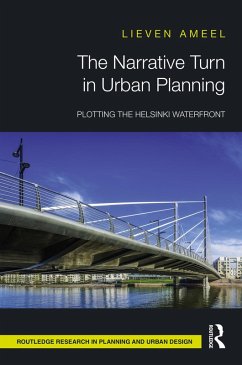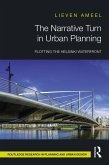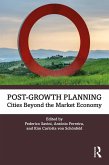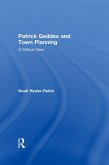40,95 €
40,95 €
inkl. MwSt.
Sofort per Download lieferbar

20 °P sammeln
40,95 €
Als Download kaufen

40,95 €
inkl. MwSt.
Sofort per Download lieferbar

20 °P sammeln
Jetzt verschenken
Alle Infos zum eBook verschenken
40,95 €
inkl. MwSt.
Sofort per Download lieferbar
Alle Infos zum eBook verschenken

20 °P sammeln
- Format: ePub
- Merkliste
- Auf die Merkliste
- Bewerten Bewerten
- Teilen
- Produkt teilen
- Produkterinnerung
- Produkterinnerung

Bitte loggen Sie sich zunächst in Ihr Kundenkonto ein oder registrieren Sie sich bei
bücher.de, um das eBook-Abo tolino select nutzen zu können.
Hier können Sie sich einloggen
Hier können Sie sich einloggen
Sie sind bereits eingeloggt. Klicken Sie auf 2. tolino select Abo, um fortzufahren.

Bitte loggen Sie sich zunächst in Ihr Kundenkonto ein oder registrieren Sie sich bei bücher.de, um das eBook-Abo tolino select nutzen zu können.
In two extended case studies from the planning of the Helsinki waterfront, this book applies the narrative concepts and theories to a broad range of texts and practices, considering ways toward a more conscious and contextualised future urban planning.
- Geräte: eReader
- ohne Kopierschutz
- eBook Hilfe
- Größe: 3.05MB
Andere Kunden interessierten sich auch für
![The Narrative Turn in Urban Planning (eBook, PDF) The Narrative Turn in Urban Planning (eBook, PDF)]() Lieven AmeelThe Narrative Turn in Urban Planning (eBook, PDF)40,95 €
Lieven AmeelThe Narrative Turn in Urban Planning (eBook, PDF)40,95 €![The Architecture and Landscape of Health (eBook, ePUB) The Architecture and Landscape of Health (eBook, ePUB)]() Julie CollinsThe Architecture and Landscape of Health (eBook, ePUB)42,95 €
Julie CollinsThe Architecture and Landscape of Health (eBook, ePUB)42,95 €![Post-Growth Planning (eBook, ePUB) Post-Growth Planning (eBook, ePUB)]() Post-Growth Planning (eBook, ePUB)39,95 €
Post-Growth Planning (eBook, ePUB)39,95 €![The Routledge Companion to Twentieth and Early Twenty-First Century Urban Design (eBook, ePUB) The Routledge Companion to Twentieth and Early Twenty-First Century Urban Design (eBook, ePUB)]() Jon LangThe Routledge Companion to Twentieth and Early Twenty-First Century Urban Design (eBook, ePUB)46,95 €
Jon LangThe Routledge Companion to Twentieth and Early Twenty-First Century Urban Design (eBook, ePUB)46,95 €![Architecture and the Nazi Cultural Landscape (eBook, ePUB) Architecture and the Nazi Cultural Landscape (eBook, ePUB)]() David H. HaneyArchitecture and the Nazi Cultural Landscape (eBook, ePUB)39,95 €
David H. HaneyArchitecture and the Nazi Cultural Landscape (eBook, ePUB)39,95 €![Patrick Geddes and Town Planning (eBook, ePUB) Patrick Geddes and Town Planning (eBook, ePUB)]() Noah Hysler-RubinPatrick Geddes and Town Planning (eBook, ePUB)46,95 €
Noah Hysler-RubinPatrick Geddes and Town Planning (eBook, ePUB)46,95 €![Co-Crafting the Just City (eBook, ePUB) Co-Crafting the Just City (eBook, ePUB)]() James A. ThrogmortonCo-Crafting the Just City (eBook, ePUB)34,95 €
James A. ThrogmortonCo-Crafting the Just City (eBook, ePUB)34,95 €-
-
-
In two extended case studies from the planning of the Helsinki waterfront, this book applies the narrative concepts and theories to a broad range of texts and practices, considering ways toward a more conscious and contextualised future urban planning.
Dieser Download kann aus rechtlichen Gründen nur mit Rechnungsadresse in A, B, BG, CY, CZ, D, DK, EW, E, FIN, F, GR, HR, H, IRL, I, LT, L, LR, M, NL, PL, P, R, S, SLO, SK ausgeliefert werden.
Produktdetails
- Produktdetails
- Verlag: Taylor & Francis eBooks
- Seitenzahl: 172
- Erscheinungstermin: 15. November 2020
- Englisch
- ISBN-13: 9781000221633
- Artikelnr.: 60309894
- Verlag: Taylor & Francis eBooks
- Seitenzahl: 172
- Erscheinungstermin: 15. November 2020
- Englisch
- ISBN-13: 9781000221633
- Artikelnr.: 60309894
- Herstellerkennzeichnung Die Herstellerinformationen sind derzeit nicht verfügbar.
Lieven Ameel is a university lecturer in comparative literature at Tampere University, Finland. He holds a PhD in Finnish literature and comparative literature from the University of Helsinki and the JLU Giessen and is docent in urban studies and planning methods. He has published widely on literary experiences of the city, narrative planning, and urban futures. His other books include Helsinki in Early Twentieth-Century Literature (2014) and the co-edited volumes Literature and the Peripheral City (2015), Literary Second Cities (2017), and The Materiality of Literary Narratives in Urban History (2019).
Preface
Acknowledgements
1. Introduction: Examining Narratives in the Context of Urban planning
Narratives Matter
Aims
Plotting the Waterfront
The Helsinki Waterfront, Jätkäsaari and Kalasatama
Sources
Outline
2. Urban Planning and Narrative: Towards a Theory of Narrative Planning
The Narrative Turn in Planning: A Critical Overview
Different Kinds of Knowledge
Defining Narrative in Planning
What Is Not a Story?
3. Narrative for, in and of Planning
A Threefold Taxonomy
Narratives for Planning
Narrative Mapping
Mapping the Helsinki Waterfront: A Concise Literary Case Study
Narratives in Planning: The Brief Story of the Helsinki Waterfront
Planning Maritime Helsinki
Narratives of Planning: Telling the Future of the Waterfront
Conclusion
4. Emplotting Urban Regeneration: Narrative Strategies in Kalasatama
Emplotment as Spatial and Narrative Practice
Situating Kalasatama within a Plot
Metaphors of Kalasatama: "In the Armpit of the City"
Diverging Narratives: Urban Centre or Shopping Mall?
"How we live in 2033"
A Meshwork of Contradictory Storylines
Conclusion
5. Genre and Metaphor in Planning Jätkäsaari
Dominant Narratives in Planning in Jätkäsaari
Simple Story, Complex Story, and Micro-Narrative
Narratives for Planning in Jätkäsaari
Jätkäsaari's Identity Marker: The Hotel Controversy
Centre or Periphery?
Narratives of Planning in Jätkäsaari
A Bildungsroman for a Waterfront Development
Planning as Bildungsroman
"Man's Island" or "Women's City"?
Lost Opportunities for Planning with Narrative
Park "Good Hope"
Sustainable Jätkäsaari
Narratives and the Building Block
Planning with Diversity?
Conclusion
6. Planning with Narrative
Narrative Mapping and PPGIS
Planning with Polyphony
Planning without Closure
Planning for Narrative Space
Teaching Planning with narrative
Conclusion
Sources
Glossary
Index
Acknowledgements
1. Introduction: Examining Narratives in the Context of Urban planning
Narratives Matter
Aims
Plotting the Waterfront
The Helsinki Waterfront, Jätkäsaari and Kalasatama
Sources
Outline
2. Urban Planning and Narrative: Towards a Theory of Narrative Planning
The Narrative Turn in Planning: A Critical Overview
Different Kinds of Knowledge
Defining Narrative in Planning
What Is Not a Story?
3. Narrative for, in and of Planning
A Threefold Taxonomy
Narratives for Planning
Narrative Mapping
Mapping the Helsinki Waterfront: A Concise Literary Case Study
Narratives in Planning: The Brief Story of the Helsinki Waterfront
Planning Maritime Helsinki
Narratives of Planning: Telling the Future of the Waterfront
Conclusion
4. Emplotting Urban Regeneration: Narrative Strategies in Kalasatama
Emplotment as Spatial and Narrative Practice
Situating Kalasatama within a Plot
Metaphors of Kalasatama: "In the Armpit of the City"
Diverging Narratives: Urban Centre or Shopping Mall?
"How we live in 2033"
A Meshwork of Contradictory Storylines
Conclusion
5. Genre and Metaphor in Planning Jätkäsaari
Dominant Narratives in Planning in Jätkäsaari
Simple Story, Complex Story, and Micro-Narrative
Narratives for Planning in Jätkäsaari
Jätkäsaari's Identity Marker: The Hotel Controversy
Centre or Periphery?
Narratives of Planning in Jätkäsaari
A Bildungsroman for a Waterfront Development
Planning as Bildungsroman
"Man's Island" or "Women's City"?
Lost Opportunities for Planning with Narrative
Park "Good Hope"
Sustainable Jätkäsaari
Narratives and the Building Block
Planning with Diversity?
Conclusion
6. Planning with Narrative
Narrative Mapping and PPGIS
Planning with Polyphony
Planning without Closure
Planning for Narrative Space
Teaching Planning with narrative
Conclusion
Sources
Glossary
Index
Preface
Acknowledgements
Conclusion
Sources
Glossary
Index
Acknowledgements
- Introduction: Examining Narratives in the Context of Urban planning
- Urban Planning and Narrative: Towards a Theory of Narrative Planning
- Narrative for, in and of Planning
- Emplotting Urban Regeneration: Narrative Strategies in Kalasatama
- Genre and Metaphor in Planning Jätkäsaari
- Planning with Narrative
Narratives Matter
Aims
Plotting the Waterfront
The Helsinki Waterfront, Jätkäsaari and Kalasatama
Sources
Outline
The Narrative Turn in Planning: A Critical Overview
Different Kinds of Knowledge
Defining Narrative in Planning
What Is Not a Story?
A Threefold Taxonomy
Narratives for Planning
Narrative Mapping
Mapping the Helsinki Waterfront: A Concise Literary Case Study
Narratives in Planning: The Brief Story of the Helsinki Waterfront
Planning Maritime Helsinki
Narratives of Planning: Telling the Future of the Waterfront
Conclusion
Emplotment as Spatial and Narrative Practice
Situating Kalasatama within a Plot
Metaphors of Kalasatama: "In the Armpit of the City"
Diverging Narratives: Urban Centre or Shopping Mall?
"How we live in 2033"
A Meshwork of Contradictory Storylines
Conclusion
Dominant Narratives in Planning in Jätkäsaari
Simple Story, Complex Story, and Micro-Narrative
Narratives for Planning in Jätkäsaari
Jätkäsaari's Identity Marker: The Hotel Controversy
Centre or Periphery?
Narratives of Planning in Jätkäsaari
A Bildungsroman for a Waterfront Development
Planning as Bildungsroman
"Man's Island" or "Women's City"?
Lost Opportunities for Planning with Narrative
Park "Good Hope"
Sustainable Jätkäsaari
Narratives and the Building Block
Planning with Diversity?
Conclusion
Narrative Mapping and PPGIS
Planning with Polyphony
Planning without Closure
Planning for Narrative Space
Teaching Planning with narrative
Conclusion
Sources
Glossary
Index
Preface
Acknowledgements
1. Introduction: Examining Narratives in the Context of Urban planning
Narratives Matter
Aims
Plotting the Waterfront
The Helsinki Waterfront, Jätkäsaari and Kalasatama
Sources
Outline
2. Urban Planning and Narrative: Towards a Theory of Narrative Planning
The Narrative Turn in Planning: A Critical Overview
Different Kinds of Knowledge
Defining Narrative in Planning
What Is Not a Story?
3. Narrative for, in and of Planning
A Threefold Taxonomy
Narratives for Planning
Narrative Mapping
Mapping the Helsinki Waterfront: A Concise Literary Case Study
Narratives in Planning: The Brief Story of the Helsinki Waterfront
Planning Maritime Helsinki
Narratives of Planning: Telling the Future of the Waterfront
Conclusion
4. Emplotting Urban Regeneration: Narrative Strategies in Kalasatama
Emplotment as Spatial and Narrative Practice
Situating Kalasatama within a Plot
Metaphors of Kalasatama: "In the Armpit of the City"
Diverging Narratives: Urban Centre or Shopping Mall?
"How we live in 2033"
A Meshwork of Contradictory Storylines
Conclusion
5. Genre and Metaphor in Planning Jätkäsaari
Dominant Narratives in Planning in Jätkäsaari
Simple Story, Complex Story, and Micro-Narrative
Narratives for Planning in Jätkäsaari
Jätkäsaari's Identity Marker: The Hotel Controversy
Centre or Periphery?
Narratives of Planning in Jätkäsaari
A Bildungsroman for a Waterfront Development
Planning as Bildungsroman
"Man's Island" or "Women's City"?
Lost Opportunities for Planning with Narrative
Park "Good Hope"
Sustainable Jätkäsaari
Narratives and the Building Block
Planning with Diversity?
Conclusion
6. Planning with Narrative
Narrative Mapping and PPGIS
Planning with Polyphony
Planning without Closure
Planning for Narrative Space
Teaching Planning with narrative
Conclusion
Sources
Glossary
Index
Acknowledgements
1. Introduction: Examining Narratives in the Context of Urban planning
Narratives Matter
Aims
Plotting the Waterfront
The Helsinki Waterfront, Jätkäsaari and Kalasatama
Sources
Outline
2. Urban Planning and Narrative: Towards a Theory of Narrative Planning
The Narrative Turn in Planning: A Critical Overview
Different Kinds of Knowledge
Defining Narrative in Planning
What Is Not a Story?
3. Narrative for, in and of Planning
A Threefold Taxonomy
Narratives for Planning
Narrative Mapping
Mapping the Helsinki Waterfront: A Concise Literary Case Study
Narratives in Planning: The Brief Story of the Helsinki Waterfront
Planning Maritime Helsinki
Narratives of Planning: Telling the Future of the Waterfront
Conclusion
4. Emplotting Urban Regeneration: Narrative Strategies in Kalasatama
Emplotment as Spatial and Narrative Practice
Situating Kalasatama within a Plot
Metaphors of Kalasatama: "In the Armpit of the City"
Diverging Narratives: Urban Centre or Shopping Mall?
"How we live in 2033"
A Meshwork of Contradictory Storylines
Conclusion
5. Genre and Metaphor in Planning Jätkäsaari
Dominant Narratives in Planning in Jätkäsaari
Simple Story, Complex Story, and Micro-Narrative
Narratives for Planning in Jätkäsaari
Jätkäsaari's Identity Marker: The Hotel Controversy
Centre or Periphery?
Narratives of Planning in Jätkäsaari
A Bildungsroman for a Waterfront Development
Planning as Bildungsroman
"Man's Island" or "Women's City"?
Lost Opportunities for Planning with Narrative
Park "Good Hope"
Sustainable Jätkäsaari
Narratives and the Building Block
Planning with Diversity?
Conclusion
6. Planning with Narrative
Narrative Mapping and PPGIS
Planning with Polyphony
Planning without Closure
Planning for Narrative Space
Teaching Planning with narrative
Conclusion
Sources
Glossary
Index
Preface
Acknowledgements
Conclusion
Sources
Glossary
Index
Acknowledgements
- Introduction: Examining Narratives in the Context of Urban planning
- Urban Planning and Narrative: Towards a Theory of Narrative Planning
- Narrative for, in and of Planning
- Emplotting Urban Regeneration: Narrative Strategies in Kalasatama
- Genre and Metaphor in Planning Jätkäsaari
- Planning with Narrative
Narratives Matter
Aims
Plotting the Waterfront
The Helsinki Waterfront, Jätkäsaari and Kalasatama
Sources
Outline
The Narrative Turn in Planning: A Critical Overview
Different Kinds of Knowledge
Defining Narrative in Planning
What Is Not a Story?
A Threefold Taxonomy
Narratives for Planning
Narrative Mapping
Mapping the Helsinki Waterfront: A Concise Literary Case Study
Narratives in Planning: The Brief Story of the Helsinki Waterfront
Planning Maritime Helsinki
Narratives of Planning: Telling the Future of the Waterfront
Conclusion
Emplotment as Spatial and Narrative Practice
Situating Kalasatama within a Plot
Metaphors of Kalasatama: "In the Armpit of the City"
Diverging Narratives: Urban Centre or Shopping Mall?
"How we live in 2033"
A Meshwork of Contradictory Storylines
Conclusion
Dominant Narratives in Planning in Jätkäsaari
Simple Story, Complex Story, and Micro-Narrative
Narratives for Planning in Jätkäsaari
Jätkäsaari's Identity Marker: The Hotel Controversy
Centre or Periphery?
Narratives of Planning in Jätkäsaari
A Bildungsroman for a Waterfront Development
Planning as Bildungsroman
"Man's Island" or "Women's City"?
Lost Opportunities for Planning with Narrative
Park "Good Hope"
Sustainable Jätkäsaari
Narratives and the Building Block
Planning with Diversity?
Conclusion
Narrative Mapping and PPGIS
Planning with Polyphony
Planning without Closure
Planning for Narrative Space
Teaching Planning with narrative
Conclusion
Sources
Glossary
Index
"This is a fine contribution to the planning field and will be especially helpful to those interested in the stories told around planning strategies and projects. It draws together and enriches the literature on narrative and storytelling, both generally and specifically in relation to planning and urban studies. It contains two well-developed case studies of major redevelopment projects in one of Northern Europe's major cities which illustrate the different ways narratives inform, get used in and are generated by planning activity. Many will find this book a really helpful resource."
- Patsy Healey, professor Emeritus, School of Architecture, Planning and Landscape, Newcastle University, UK
- Patsy Healey, professor Emeritus, School of Architecture, Planning and Landscape, Newcastle University, UK







